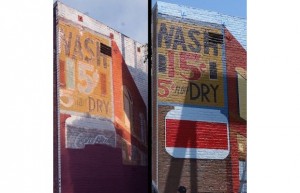Victor Henderson, creator of the Los Angeles mural “Brooks Avenue Painting,” has filed a lawsuit alleging a violation of his right of integrity under the Visual Artists Rights Act (“VARA”). 
Henderson painted the mural in 1969—together with the late Terry Schoonhoven—soon after the two artists founded the Los Angeles Fine Arts Squad. The painting became famous as the background for a photograph of the band “The Doors.”
The lawsuit alleges violations of VARA under Section 106A(a)(3), which protects visual artists’ right of integrity. More specifically, 106A(a)(3) states that authors of a work of visual art shall have the right:
(A) to prevent any intentional distortion, mutilation, or other modification of that work which would be prejudicial to his or her honor or reputation, and any intentional distortion, mutilation, or modification of that work is a violation of that right, and
(B) to prevent any destruction of a work of recognized stature, and any intentional or grossly negligent destruction of that work is a violation of that right.
According to Henderson, the defendants (including Ralph Ziman, the building owner at the time, and the unknown contractors who performed the work) water blasted the mural during the summer of 2013 without any notice to Henderson. Henderson alleges that Ziman proceeded to replace the mural with “a replica that does not reflect the quality work of Henderson and Schoonhooven.” Henderson asserts that the painting could have been removed if he had known about the plans to replace it.
Unlike the recent 5Pointz case under VARA that fell short of protecting the well known New York “Graffiti Mecca” from being whitewashed, Henderson’s mural has already been destroyed, and he seeks money damages for the harm that he argues has resulted to his reputation as an artist. Henderson seeks damages for the destruction of his public painting and the substitution of a copy in its place, as well as punitive damages aimed at preventing similar destruction of public art in the future. The complaint brings three other causes of action: intentional desecration of fine art under the California Art Preservation Act, conversion, and negligence.
At the outset, the threshold requirement of “recognized stature” may be easier to determine here than it was in 5Pointz because of Henderson’s reputation, though as that case spotlighted, the legal standards for recognized stature are evolving. Henderson’s is a single work that has had a significant presence in Los Angeles for years (it is noted on the web page of the Los Angeles Mural conservancy). The complaint goes to great lengths to describe Henderson’s reputation as an artist and the recognition his public paintings have received since the formation of the LA Art Squad in the late 1960s.
Judge Block’s decision in the 5Pointz case could still cast an analytical shadow over this one, however. That court denied the requested injunction in part because it held that there was no irreparable harm because “paintings generally are meant to be sold.” As pointed out here earlier, that holding undercuts the very purpose of VARA—to protect moral rather than economic rights of artists. Nonetheless, that was the court’s ruling. If the value of what is lost is linked to its market value then Henderson could face an obstacle (because he may not have had the full property rights in the wall on which it was painted, though he seems to dispute that it was fixed). That may be why he also seeks VARA reputation damages; in that event, the money he recovers will not be tied to the value of an art object, but to the pecuniary harm that he has suffered as an artist because of the mural’s destruction. As Carter v. Helmsley-Spear, Inc. held, VARA—as one of the few U.S. codifications of le droit moral—is based on: “a belief that an artist in the process of creation injects his spirit into the work and that the artist's personality as well as the integrity of the work, should therefore be protected and preserved.”
Henderson’s could prove to be a significant development for VARA litigation. As always, stay tuned.
Special thanks to my colleague Maria Granik for her contribution to this post.




